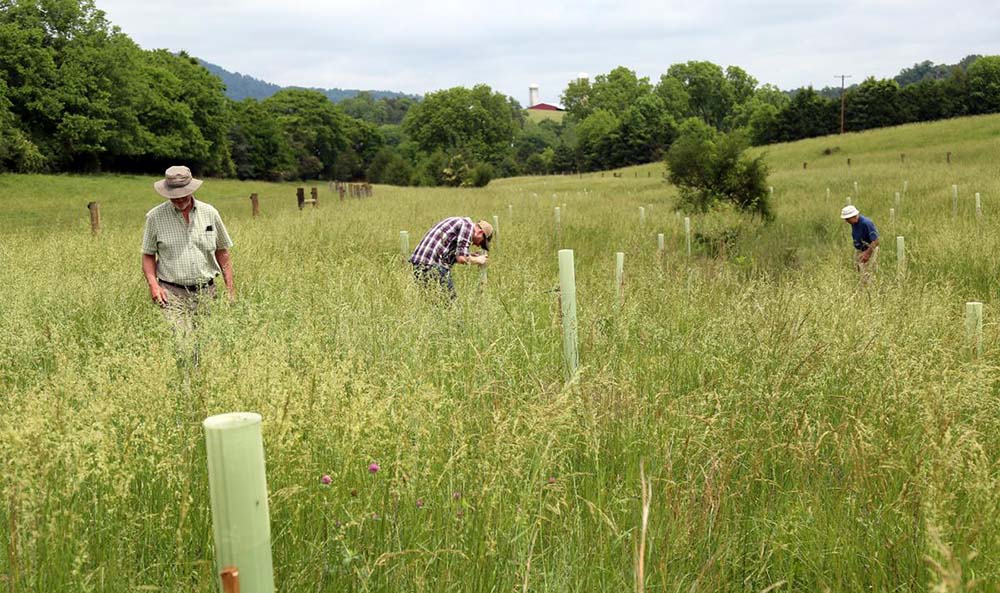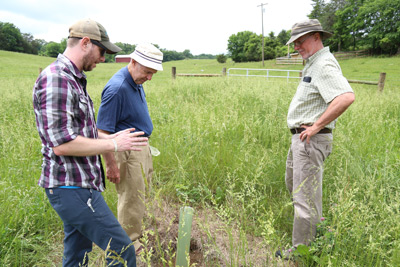
Distracted by an iconic red barn sitting atop picturesque rolling hills, I passed the gravel driveway I was supposed to turn down. As I found my way back, I saw the very reason I was visiting the Goodall property in Madison County. Long rows of newly planted trees nestled inside light green tubes stretched along a tributary of the Robinson River.
I met with brothers, Paul and Joe Goodall, to discuss their family’s participation in the Headwaters Stream Initiative, a partnership program coordinated by Friends of the Rappahannock (FOR) and The Piedmont Environmental Council (PEC) to protect and restore the Rappahannock River watershed by working with landowners to plant native trees and shrubs and re-establish riparian buffers along waterways, which provide a healthy habitat for fish, wildlife and livestock.

Photo by Paula Combs.
We met at, what they charmingly call, the Johnson Place, one of their farmhouses. The Goodalls pay homage to each family they purchased land from, by continuing to call the property by the original owner’s name. The first, still referred to as the Goodall Place, was purchased in 1906 by Paul and Joe’s grandfather. Their father, Culton Goodall, later purchased the Thomas Place in the mid 30’s and also the Johnson Place in the late 60’s. All three pieces connect and come to approximately 600 acres, encompassing a variety of valuable landscape.
“The diversity on the property you get to see is pretty unique. You have a huge wetland area, a tiny creek, a farm pond, rolling hills with giant boulders, and cattle pasture and flat hayfields; and then you have the Robinson River. So many different ecosystems, all on the same property,” said Bryan Hofmann, programs manager at FOR.
“Dad was a very good farmer. A good dad too. And he was very appreciative of the land, and kept trying to improve his agricultural practices,” said Paul.
Following their father’s footsteps and wishes, the Goodall brothers have continued implementing best management practices (BMPs). Through the Headwaters Stream Initiative, an astounding 3,765 trees were planted on 16 acres, including 4,600 linear feet of stream, this past spring. The partnership between PEC, FOR, Culpeper Soil and Water Conservation District (CSWCD) and the Virginia Department of Forestry (VDOF), along with over 100 student volunteers from six schools, made this project possible.
Through the Headwaters Stream Initiative, an astounding 3,765 trees were planted on 16 acres, including 4,600 linear feet of stream
“It was, far and away, the largest single season planting we’ve done,” said Peter Hujik, field representative for PEC. “I enjoyed working with the Goodalls, and it was great to see so many students involved.”
As part of a different clean water effort, the Goodalls worked with CSWCD to install a mechanical watering system for cattle and approximately 1.5 miles of fencing.
The brothers are already planning for their next steps. “We are definitely going to fence off the streams on the east portion of The Thomas Place; and we’re interested in tree planting over there too. So hopefully next spring we can have a reprise of this,” said Paul.
The Goodall family not only planted seeds to grow trees — literally by their own hand and shovel — but clearly a seed of love for the land was planted long ago by their father. And it continues to grow to this day.
Additional Headwaters Stream Initiative projects completed this year
Ridder Property, Last Resort Farm — Rappahannock River
PEC and FOR teamed up with 15 students from Wakefield Country Day School to plant 235 native trees and shrubs and 250 live stakes for a .75-acre buffer along the Rappahannock River, near Flint Hill. This is the third phase of an extensive HSI project that has improved 3 acres of riparian buffer to date.
Bagley Property, Fields of Athenrye — Hazel River
Over 75 students and community volunteers, including Rappahannock High School, Mountain View High School and Belle Meade Montessori, joined together to lend a hand planting 280 trees on one acre along the Hazel River. This riparian buffer brings new native shrub and tree species that will provide new habitat for pollinators, birds and other wildlife along the river.
Ward Property — Hughes River
Virginia Department of Forestry (VDOF), FOR, PEC and community volunteers joined with landowners to plant 65 trees and shrubs along 500 linear feet of a tributary to the Hughes River. The landowners selected native paw paw trees and indigo bush, among other fruit and flower producing tree and shrubs, to ornament their stretch of Sherman’s Run, a headwater tributary to the Hughes River.
Hussen-Lewis Property — Buck Run
PEC, John Marshall SWCD, and FOR worked together for a second round of riparian planting on Buck Run with the help of 25 Highland School students and other volunteers who planted 150 trees on 1.25 acres of riparian buffer, and they received special instruction from VDOF’s Joe Rosetti on proper planting techniques, riparian tree ecosystem services and invasive species.
Marriott Ranch — Fiery Run
FOR, John Marshall Soil and Water Conservation District (SWCD) and PEC held the 5th Annual “From the Rappahannock, For the Rappahannock” on Earth Day, April 22, 2018 at the Marriott Ranch. This celebration of protecting clean water brought together 95 volunteers, who planted 320 trees along 2,300 linear feet of stream and along 3 riparian acres of Fiery Run and the Rappahannock River, which is within the cattle-exclusion fencing that was installed by JMSWCD through the Virginia Agricultural Cost Share Program (VACS).
Allen Property — Robinson River
FOR worked with 37 students from Orange County High School joined together to plant 185 trees along 1,000 linear feet of the Robinson River.
These projects were made possible through the generous support of our Piedmont Soil and Water Conservation Districts, Virginia Department of Forestry, National Fish and Wildlife Foundation, PEC’s Krebser Fund for Rappahannock Conservation, Richard Lykes and Patagonia. And an enormous thank you to the many others who have contributed to these efforts. To see a full list of partners and funders, visit pecva.org/buffers
This article was featured in our Summer 2018 member newsletter, The Piedmont View.
